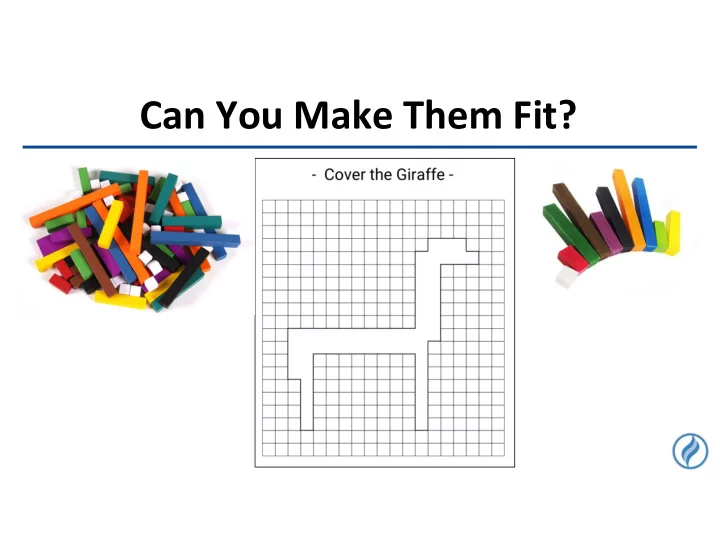

Can You Make Them Fit?
Can You Make Them Fit? What were you thinking about as you tried to complete the picture?
Beyond Numbers: Building Spatial Reasoning in Children Dennis McDonald dmcdonald@hcpss.org Mathematics Support Teacher Talbott Springs Elementary 11/14/19 @HCPSSElemMath
What is Spatial Reasoning? • composing and decomposing shapes and figures • visualization, or the ability to mentally manipulate, rotate, twist, or invert pictures or objects • spatial orientation, or the ability to recognize an object even when the object’s orientation changes • spatial relations, or the ability to recognize spatial patterns, to understand spatial hierarchies, and to imagine maps from verbal descriptions Rich and Brendefur (2018)
What is Spatial Reasoning? Spatial thinking is what allows us to mentally “picture the locations of objects, their shapes, their relations to each other and the paths they take as they move.” Newcombe (2010)
Why Emphasize Spatial Reasoning? “Brain imaging studies confirm that similar areas are activated when people process both spatial and number tasks.” Hubbard et al. (2005) Umiltà, Priftis, & Zorzi (2009)
Why Emphasize Spatial Reasoning? “Students who perform better on spatial tasks also perform better on tests of mathematical ability” Cheng, Mix (2014)
Spatial Ability & Careers Rich and Brendefur (2018)
Where on TOP (Google) Earth am I? LEFT RIGHT BOTTOM
Building Spatial Reasoning • Explore with maps.
Building Spatial Reasoning • Use spatial talk. "Which way does the sheet fit on the bed? Does the left shoelace go over or under—and which one is the left? Will the groceries fit in one bag? Which shapes do I get if I cut my bagel the other way— and will it still fit in the toaster?” – Nora Newcombe and Andrea Frick (2010)
Building Spatial Reasoning • Encourage gesturing. [P]eople were better at performing mental rotation tasks (a key measure of spatial thinking) when they were encouraged to use their hands – Chu and Kita (2011) 5-year-olds who spontaneously gestured during spatial problem-solving were more like to get the right answer – Ehrlich et al (2006)
Building Spatial Reasoning • Provide opportunities for 8-year-old children showed measurable improvements in their mental rotation using building toys and abilities after just five, 30-minute play puzzles. sessions. Post-training, they also showed changes in brain activity, suggesting that these kids had changed the way they processed spatial information. – Newman et al (2016)
Building Spatial Reasoning • Provide opportunities for For instance, a study of British primary school students found that kids with origami and other paper- stronger mental folding abilities scored folding crafts better on tests biology, physics, and chemistry. – Hodgkiss, et al (2018) school children improved their performance on a very challenging mental folding task after just a few hours of instruction in and hands-on exploration of origami – Burte, et al (2017)
Questions?
Recommend
More recommend